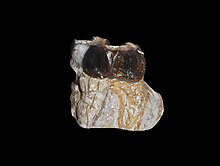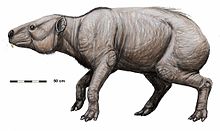Titanohyrax is an extinct genus of large to very large hyrax from the Eocene and Oligocene. Specimens have been discovered in modern-day Algeria, Tunisia, Egypt and Libya. Some species, like T. ultimus, are estimated to be as large as the modern rhinoceros. Titanohyrax species are still poorly known due to their rarity in the fossil record.
| Titanohyrax Temporal range:
| |
|---|---|

| |
| Teeth | |
| Scientific classification | |
| Domain: | Eukaryota |
| Kingdom: | Animalia |
| Phylum: | Chordata |
| Class: | Mammalia |
| Order: | Hyracoidea |
| Family: | †Titanohyracidae |
| Genus: | †Titanohyrax Matsumoto, 1922[1] |
| Type species | |
| Titanohyrax andrewsi | |
| Species | |
| |

Titanohyrax is unusual among the numerous Paleogene hyracoids by its lophoselenodont teeth (having teeth that are lophodont and selenodont), fully molariform premolars, and relatively high-crowned cheek teeth. This suggests the genus had a folivorous diet.[2]
The genus was first described by in 1922 for the species T. ultimus from the early Oligocene of the Jebel Qatrani Formation, Fayum Depression, Egypt.[3] The author described it as an “extremely gigantic species, being the largest of all the hyracoids hitherto known” – estimates of body mass range from 600 kg (1,300 lb) to 1,300 kg (2,900 lb).[4] T. tantulus is the smallest Titanohyrax species known, with a body mass of around 23 kg (51 lb).[4]
See also
editReferences
edit- ^ Matsumoto, H., 1922. Megalohyrax, Andrews and Titanohyrax, gen. nov. A revision of the genera of hyracoids from the Fayum, Egypt. Proceedings of the Zoological Society 1921, 839-850
- ^ Rasmussen, D. T., 1989. The evolution of the Hyracoidea: a review of the fossil evidence. In: Prothero, D.R., Schoch, R.M. (Eds.), The Evolution of Perissodactyls. Oxford University Press, New York, pp. 57-78.
- ^ Court, N.; Hartenberger, J. (1992). "A new Species of the Hyracoid Mammal Titanohyrax from the Eocene of Tunisia" (PDF). Palaeontology. 35 (2): 309–317.
- ^ a b Rodolphe Tabuce (2016). "A mandible of the hyracoid mammal Titanohyrax andrewsi in the collections of the Muséum National d'Histoire Naturelle, Paris (France) with a reassessment of the species". Palaeovertebrata. 40 (1): e4. doi:10.18563/pv.40.1.e4.
Sources
edit- Fossils (Smithsonian Handbooks) by David Ward (Page 277)